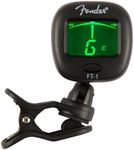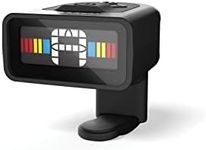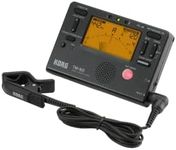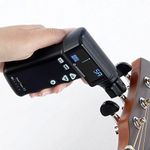Buying Guide for the Best Guitar Tuners
Choosing the right guitar tuner can make tuning your instrument quick, accurate, and stress-free. With so many types and features available, it's important to understand what matters most for your playing style and environment. Whether you play at home, on stage, or in a studio, the right tuner will help you sound your best and keep your guitar in perfect pitch.Tuner TypeTuner type refers to the way the tuner detects and displays the pitch of your guitar strings. The main types are clip-on, pedal, handheld, and app-based tuners. Clip-on tuners attach to your guitar's headstock and sense vibrations, making them great for noisy environments. Pedal tuners are used with electric guitars and fit into your pedalboard, ideal for live performances. Handheld tuners are portable and versatile, while app-based tuners use your phone's microphone. Your choice should depend on where and how you play: clip-ons are best for acoustic players or quiet practice, pedals for gigging electric guitarists, and handheld or app tuners for general use.
Display TypeDisplay type is how the tuner shows you whether your string is in tune. Common displays include LED, LCD, and analog needle. LED and LCD displays are bright and easy to read, even on dark stages, while analog needles offer a classic look and smooth movement. If you often play in low-light settings, a bright LED or backlit LCD is helpful. For home use, any display type works, so pick what feels easiest for you to read quickly.
Tuning AccuracyTuning accuracy is measured in cents, with lower numbers meaning more precise tuning. Most tuners offer accuracy between ±0.1 and ±1 cent. If you play professionally or record music, higher accuracy (closer to ±0.1 cent) ensures your guitar is perfectly in tune. For casual practice, a tuner with ±1 cent accuracy is usually sufficient. Think about how critical perfect tuning is for your playing situation to decide how much accuracy you need.
Tuning ModesTuning modes refer to the different ways a tuner can help you tune your instrument. Some tuners offer chromatic mode, which recognizes all notes, while others are limited to standard guitar tuning. Advanced tuners may include alternate tunings or support for other instruments. If you only play standard guitar, a basic mode is fine. If you experiment with alternate tunings or play multiple instruments, look for a chromatic tuner with extra modes.
Power SourcePower source describes how the tuner is powered—common options are batteries, rechargeable batteries, or plugging into a power supply. Clip-on and handheld tuners usually use small batteries, while pedal tuners often require a 9V battery or power adapter. If you travel a lot, consider battery life and ease of replacement. For stationary setups, a plug-in option can be more convenient.
Durability and Build QualityDurability and build quality determine how well the tuner will hold up to regular use and possible drops. Plastic tuners are lightweight but may be less sturdy, while metal or reinforced designs last longer, especially for gigging musicians. If you plan to carry your tuner around or use it on stage, look for a robust build. For home use, durability is less critical, so a lighter, simpler tuner may suffice.














